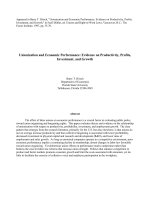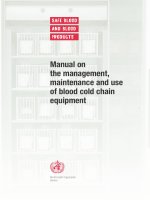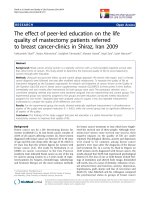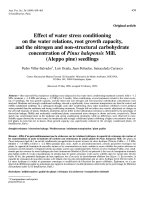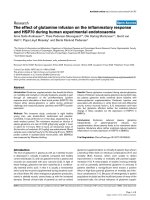Effect of different compost as pond manure on the water quality and growth of Labeo rohita (ham.)
Bạn đang xem bản rút gọn của tài liệu. Xem và tải ngay bản đầy đủ của tài liệu tại đây (483.03 KB, 8 trang )
Int.J.Curr.Microbiol.App.Sci (2019) 8(2): 1251-1258
International Journal of Current Microbiology and Applied Sciences
ISSN: 2319-7706 Volume 8 Number 02 (2019)
Journal homepage:
Original Research Article
/>
Effect of Different Compost as Pond Manure on the Water Quality and
Growth of Labeo rohita (ham.)
Kamla Shankar Shukla, C.M. Tripathi and Aditya Kumar Singh*
Krishi Vigyan Kendra, Ganiwan, Chitrakoot, UP, India
*Corresponding author
ABSTRACT
Keywords
Cattle dung, Vermi
compost, Pit
compost, Water
quality, Weight gain
Article Info
Accepted:
10 January 2019
Available Online:
10 February 2019
The present study was conducted at Krishi Vigyan Kendra, Chitrakoot in earthen pond
having the area of 0.017 to 0.041 ha for 120 days to study the effect of different organic
manure on water quality and growth performance Labeo rohita. The compost comprises as
vermicompost, Pit compost and raw cattle dung that is compared with control having no
manure application. All the compost was used at fixed dose @ 5000 Kg/ ha in 24 split
doses at 15 days interval and 5000 kg/ha compost applied at 15 days prior to stocking of
fish seed for pond preparation. No feed was given to fishes as supplementary feed during
the study period. The physio – chemical parameters were studied at monthly basis. The
parameter increased significantly in the pond over control. The maximum weight gain of
rohu was obtained in vermicompost treated pond that is 90.15 gm with highest survival of
fishes (83.4%), 44.2 gm in raw cattle dung treated pond with 68.97% survival and 63.13
survival with 34.35 gm individual weight in pit compost treated pond.
Introduction
Aquaculture is the fastest growing food
production sector in the world with annual
growth in excess of 10 percent over the last
two decades. Much of this development has
occurred in Asia, which also has the greatest
variety of cultured species and systems.
Organic fertilizers are used to enhance the
productivity of inland aquatic resources.
These fertilizers directly influence the water
quality parameters which is liable to form the
aquatic environment. Vermi compost is a new
and valuable introduction to the list of organic
fertilizers used in aquaculture production. A
sustainable technology is required to get
higher production from existing agricultural
resources. For long sustainability of the
production potential there is a need to utilize
all available resources and production system
within each and every system. Utilization of
byproduct of one farming system to another
farming system is a need of today. Not only
for sustainable farming but also to keep
environment clean in which we are
habituating. If we are unable to use these by
products, that putrefy our local environment
with bad odor, pollute air with the production
of noxious gases. The byproduct of farming
system when accumulated in open air it
produces several hazards to the human beings
like, Malaria, Asthmas, dengue and polluted
drinking water. Disposal of Agri by products
1251
Int.J.Curr.Microbiol.App.Sci (2019) 8(2): 1251-1258
through proper manner without burning and
recycled them to earn more benefit without
polluting the environment.
To study the Growth performance of Labeo
rohita in different organic manure loaded
pond.
Cost minimization and effective management
of farm waste through different farming
system helps to increase farmer’s income and
profitability. Increasing cost of highly
proteinaceous fish production inputs likefeed, manures and fertilizers creating an
interest of farming community for utilization
of animal waste in aquaculture. So many
aquaculture production systems are in practice
like- Intensive, Semi intensive and traditional
system using different level of input use.
These Manures are either directly used by
fishes or through production of Phyto and Zoo
plank tonic communities. The vast availability
of crop, live stock, poultry and pigs waste
products may play a vital role in improving
the livelihood of rural community with
minimizing the pollution and maximizing the
production. The live stock waste including
animal manure, poultry by products and
agriculture Waste contains variety of plants
rich in protein, lipid, carbohydrates and many
trace minerals and vitamins which play
crucial role in production enhancement in
aquaculture system. It is also necessary to
manage water quality of ponds loaded with
Organic manure. The nutrient and over
loading of manure produces much stress to
aquatic life when the water quality get
putrefied. Tolerance in relation to the fishes
possess through a limit of water quality. The
water quality parameter when disturbed then
it causes aquatic life and even they lose their
equilibrium and ultimately they die. So, we
must be conscious about their alteration and
keep eye to manage regularly.
To study the suitability of water quality of
pond loaded with organic manure for fish
farming
Main objective of the study is to assess the
effect of Organic manure on the growth of
Labeo rohita and water quality parameters of
fish pond
To study the judicious recycling of organic
wastes for the production of high quality
protein at low cost.
To analyze the water quality of aquaculture
pond receives organic manures.
Materials and Methods
The fish farming unit of Krishi Vigyan
Kendra, Chitrakoot, was selected for the study
of the Effect of different compost as pond
manure on the water quality and growth of
Labeo rohita (ham.). The site is located at
132.98 km above mean sea level of 800 40’
and 810 84’ longitude and 240 52’ and 250
25’.latitude. The selected ponds are situated at
a single place and embankment is connected
to each other. The experiment was carried out
pond measuring 133 Square meters to 326
square meter area for 125 days. The 4 ponds
were selected for the experiment and divided
as Controlled (P-1), Vermi compost (P-2), pit
compost (P-3), Raw dung (P-4). The pond
was dewatered and sanitized with 200kg/ha
lime powder. After 4 days interval it was
filled with tube well water up to the 1.25
meter height. The pond was get prepared with
selected manure at 5000 kg/ha and rest
5000kg/ha was applied after stocking at 15
days interval in 24 split doses. The pond was
stocked with Indian major carp Labeo rohita
fingerling @ 8000/ha. The average weight of
fish seed was 3.00 gram/individual. The area
of pond is not same for all treatment it was
distributed as P-1 (326 Sqm), P-2 (217 Sqm),
P-3 (133 Sqm), P-4 (177 Sqm). No
supplementary feed was given to the fishes
1252
Int.J.Curr.Microbiol.App.Sci (2019) 8(2): 1251-1258
stocked in the pond they are depending upon
natural feeds. The growth and physicochemical parameter was analyzed at monthly
interval. Fish growth was measured by body
length and weight gain monthly interval.
Weight gain= Body wt at the time of
sampling – Initial body weight
Growth increment = Total weight gain/culture
period
Sample collection method
The water sample was collected from all the
study ponds from 50 cm depth at 1: 00 pm.
The analysis of the water quality and growth
parameters completed in between 25th Sept.
to 25th Jan, 2018. The water quality
parameters analyzed by standard methods in
Laboratory and sample for D.O. was fixed at
pond site to be taken for analysis. The water
sample collected from the pond was stored in
polythene containers of 5 liter capacity. pH
and TDS estimation completed immediately
after collection of sample. The Temperature
and Transparency recorded in situ by
Thermometer and Sacchi disc.
Methods of analysis
Parameter
pH
Tranceparency
Electrical conductivity
Disolved Oxygen
Hardness
Total Alkalinity
(Gm)Growth
Method
As per standard
methods
of
examination
of
water and waste
water
Average weight
Results and Discussion
Physico-chemical and biological factor of
pond water play a significant role in the
biology, physiology and growth of the aquatic
ecosystem. So, an aquatic ecosystem, changes
in water characteristics that improve or reduce
the water quality would respectively enhance
or reduce the production of an aquatic crop
(Diana and Lin. 1998). In the present study
the water quality parameters of manure
receiving pond remained within the favorable
range required for Fish farming. Water
temperature has prominent effect on growth
rate, feed consumption and other metabolic
functions of the organisms. Osborne and
Riddle (1999) observed that fish growth
parameters in terms of weight gain, feeding
rate and feeding efficiency of grass carp
showed an increasing trend with the increase
in water temperature. As the sun shines over
the surface of water, it starts absorbing heat
and water becomes warm; the latter condition
directly influences the physiological and
metabolic activities of fish i.e., swimming,
breathing,
growth
and
reproduction
(Jhingaran, 1982). This study water
temperature ranges in between 15-28 0 C
All the metabolic and physiological activities
and life processes of aquatic organism are
greatly influenced by water temperature. The
water temperature of the pond ranges between
150C - 280C that was in the suitable range
except minimum temperature. The Indian
major carps thrive well in the temperature
range of 18.30C -37.80C (Jhingaran, 1991).
Transparency of the study P-1 pond was
ranging between 19.5-75 cm. Whereas light
penetration of P-2, P-3, P-4 pond was in
between 42.58 to 58.65, 38-70 and 36.5-90.1
Cm respectively this is congenial in range.
The transparency of treatment pond is higher
because low plank tonic organisms. In
integrated fish farming organic pollutants
released into the pond would minimize the
light penetration and D.O. (Salt et al., 1995).
The use of organic manure in fish farming is
based on the assumption that the manure is
utilized through two pathways. The manure
organic matter provides dissolved and
1253
Int.J.Curr.Microbiol.App.Sci (2019) 8(2): 1251-1258
particulate substrates for bacteria and the
bacterial laden particles provide food to the
filter-feeding and detritus-consuming animals,
while the mineralized fraction of the manure
stimulates phytoplankton productivity similar
to the action of inorganic fertilizers. The
manure organic matter coated with bacteria is
considered a link in the food web and should
be treated as a food (Hepher and Pruginin,
1981).
In intensively manured fish ponds, both
autotrophic and heterotrophic production
contribute to fish growth (Schroeder, 1978,
1980), Fish health and production are
associated with the pond environment. The
temperature, pH, dissolved oxygen and free
ammonia may have a direct adverse effect on
fish condition and growth, determining the
upper limit of the nutrient load into the fish
ponds.
The pH of all pond ranges between 7.7 to
8.6.Minimum pH was observed in control
pond and maximum pH was recorded in raw
cattle dung treated pond. The pH is favorable
in range. Each aquatic organism has its
maximum and minimum toleration range of
pH. The pH of most natural waters ranges
between 5 and 10 (Boyd, 1990).
Bhatnagar and Devi (2013) enlisted the
acceptable ranges of water quality parameters
according to these researchers, the favorable
ranges of different water parameters are: 3-5
mg L-1 Dissolved Oxygen (DO), 7-9.5 pH,
50-200 mg L-1 alkalinity, 75-150 mg L-1
hardness, 15-35°C temperature, 30-80 cm
turbidity.
The dissolved oxygen of control pond is
minimum i.e. 2.83, it is probably due to low
phyto planktonic population. The D.O. of the
all treated pond was in the favorable range for
survival to the fishes. The mean D.O. of
treated pond ranges between 8.56-8.695mg/l.
The total hardness of control pond was ranges
between 144 to 187mg/l with mean value to
167.7 mg/l. whereas in experimental pond it
was ranges between 126-172.67 mg/l. In the
vermicompost treated pond hardness was
recorded higher than all ponds.
The Total alkalinity of all the pond ranges in
between 304 to 584mg/l. The highest value
observed in control pond with mean value of
485.2 and minimum was recorded in raw
cattle dung treated pond. The higher alkalinity
is probable due to natural and rock
characteristics of the soil. Kaur and Ansal
(2010) also reported significantly higher
alkalinity in the water treated with
vermicompost as compared to other organic
manure (cow dung). Natural water bodies in
tropical areas exhibit a wide range of
fluctuation in total alkalinity which depends
on the population of primary and secondary
producers, seasons, location and nature of
bottom soil Mandal (1976). However, for a
higher production of planktons, alkalinity
must be in the favorable range.
The alkalinity was not in range for proper
growth of fishes. The electrical conductivity
is ranging in between 0.818 and 0.726 which
is congenial in range.
Organic manuring is widely practiced in carp
production systems to ensure sustained supply
of essential nutrient for augmenting natural
pond productivity to obtain increased fish
production at cheaper rates (Edwards, 1980).
The growth of Labeo rohita in control pond
was 22.25gram in 123 day culture period with
the daily weight gain of 0.182 gram. The
highest weight of 90.15 gram was observed in
vermicompost (P-2) treated pond with an
average increase of 0.733 gram/day. Whereas
raw cattle dung treated pond gives 44.20 gram
average weight of fish which is higher than
pit compost treated pond without inorganic
fertilizers and supplementary feed.
1254
Int.J.Curr.Microbiol.App.Sci (2019) 8(2): 1251-1258
Table.1 Details of trials
Details of pondsTreatment
P-1
Control (Without manure)
P-2
Vermi compost (5000 kg/ha)
P-3
Pit compost(5000 kg/ha)
P-4
Raw cattle dung (5000 kg/ha)
Table.2 Physico chemical parameter of study pond
Trial
Water temp oC
Transparency
Dissolved
Hardness
Total
(Cm)
oxygen
Mg/l
alkalinity
conductivity
(Mg/l)
ds/cm
(Mg/l)
P-1
P-2
P-3
P-4
Ph
Electrical
17-27
19.5-75
2.83-10.32
144-187
304-584
7.5-8.3
0.782-0.852
(21.75)
63.33
(6.325)
(167.7)
(485.2)
(7.775)
(0.818)
16.25-28
42-58.65
4.08-15.18
148-188.68
344-566
7.8-8.4
0.705-0.859
(21.56)
45.1
(8.56)
(163.885)
(464)
(8.07)
(0.760)
15-26.5
38-70
4.06-12.8
126-169.93
312-532
7.7-8.5
0.687-0.800
(20.88)
58.32
(8.575)
(146.19)
(449.22)
(8.1)
(0.730)
16-27
36.5-60.1
5.64-12.15
138-172.67
336-527
7.7-8.6
0.661-0.849
(21.25)
51.22
(8.695)
(149.94)
(438.24)
(8.225)
(0.726)
Table.3 Growth parameter of study pond
Trial
Initial wt of fish(gm)
Final wt of fish (Gm)
Growth increment (gm)
123 days culture period
P-1
3.0
22.25
0.182
P-2
3.0
90.15
0.733
P-3
3.0
34.35
0.279
P-4
3.0
44.20
0.359
1255
Int.J.Curr.Microbiol.App.Sci (2019) 8(2): 1251-1258
Transparancy
Dissolve…
10
Transparancy Cm
DO Mg/l
8
6
4
Dissolved oxygen
2
58.32
51.22
45.1
40
20
0
P-1
P-2
P-3
P-1
P-4
Ph level
Total alkalinity Mg/l
480
8.225
8.2
8.1
8.07
8
P-2
Ph
Tot…
464
449.22
440
7.6
P-4
485.2
460
7.775
P-3
Total alkalinity
500
8.4
438.24
420
7.4
P-1
P-2
P-3
400
P-4
P-1
Har…
Hardness
170
150
0
P-4
1
0
P-1
P-1
Weight Gain
22.25
(Gm)
130
P-3
P-4
50
140
P-2
P-3
100
Wt in gm
160
P-1
P-2
Weight Gain (Gm)
Weight gain/Day
Hardness Mg/l
63.33
60
0
7.8
Transp…
80
P-2
P-3
P-4
Traetment
Weight increament in gm
1256
P-2
P-3
90.15 34.35
P-4
44.2
Int.J.Curr.Microbiol.App.Sci (2019) 8(2): 1251-1258
Since long times, animal manures are
exploited in fish ponds as a source of soluble
phosphorus, nitrogen and carbon to maximize
the algal growth and natural food production
(Njoku, 1997). Animal manure is often used
in semi-intensive systems to improve the
primary production of the ponds and fish
growth (Nwachukwu, 1997). Manure input
and fish yield are directly related with each
other (Diana and Lin, 1998; Ansa and Jiya,
2002). Cirrhinus cirrhosus and Cyprinus
carpio showed maximum growth in manured
ponds than control ponds (Dhawan and Kaur,
2002a; 2002b). Cow dung is found to be an
effective source of organic fertilization, which
positively influences the growth performance
of major carps in respect of fish production
(Kanwal et al., 2003). High doses of cow
dung and poultry manuringis found to reduce
the value of dissolved oxygen (DO), while
optimum dose i-e 0.26 kgm-3 maintain the
better water quality and abundance of
planktonic biomass, which improves the
growth of carps species (Jha et al., 2004).
Ponds manured with cattle dung show higher
production
by
encouraging
plankton
metabolism (Terziyski et al., 2007). Organic
manuring proves to benefit the farmer
economically as it serves to reduce 50 % cost
of inorganic fertilizer and supplementary feed
(Yadava and Garg, 1992).
Summery and conclusion of the study are as
follows:
Water quality includes all physical, chemical
and biological factors that influence the
beneficial use of water. There are many water
quality variables in pond fish culture. All
other things being equal, a pond with good
water quality will produce more and healthier
fish than a pond with poor quality. Water
quality within an aquaculture pond is
continuously changing depending on certain
conditions.
The aquaculture pond integrated with pig
waste was analyzed in the present study.
Study shows that the all physico – chemical
properties of pond water were, with in the
favorable range. The prime objectives of the
study were to measure transparency, Total
dissolved solids, ambient temperature, water
temperature, and Hydrogen ion concentration.
The present study revealed that if the
aquaculture pond integrated with washings
and left over of 50-55 pigs/ha. Could not
disturbed the water quality and it is more
economic,
ecologically
balanced
and
sustainable system of recycling of organic
waste. The farmers of Bundelkhand region
should adopt integrated pig-fish farming
system to utilize available by products and
earn more profit from limited man power and
land. It is also suggested that the integrated
pond should be under close monitoring. To
maintain and manage water quality lime and
disinfectants should be applied and replace at
list 25% of water monthly to keep
environmental parameter congenial to aquatic
animals.
References
APHA., 1998. Standard Methods for the
Examination of Water and Waste Water.
19th Edn., American Public Health
Association, Washington, DC., USA.,
pp: 1360-1371.
Bhatnagar, A. and P. Devi, 2013. Water quality
guidelines for the management of pond
fish culture. Int. J. Environ. Sci., 3:
1980-2009.
Boyd, C.E., 1990. Water Quality in Ponds for
Aquaculture. 2nd Edn., Alabama
Agricultural
Experiment
Station,
Auburn University, Auburn, AL., USA.,
Pp: 482.
Dhawan and S. Kaur (2002) Pig Dung as Pond
Manure: Effect on Water, Pond
Productivity and Growth of Carps in
Polyculture System in Naga, The
ICLARM Quarterly (Vol. 25, No. 1)
1257
Int.J.Curr.Microbiol.App.Sci (2019) 8(2): 1251-1258
January-March 2002 pp11-14
Diana, J.S. and C.K. Lin, 1998. The effects of
fertilization and water management on
growth and production of Nile tilapia in
deep ponds during the dry season. J.
World Aquacult. Soc., 29: 405-413.
Edwards, P. 1980. A review of recycling
organic wastes into fish, with emphasis
on the tropics. Aquaculture, 21: 261279.
Hepher and Pruginin, 1981. Effect of Different
Levels of Cow Dung on Growth
Performance of Major Carps
Jha, P., Sarkar, K. and Barat, S. 2004. Effect of
different application rates of cowdung
and poultry excreta on water quality and
growth of ornamental carp, Cyprinus
carpio var. koi, in concrete tanks.
Turkish Journal of Fisheries and
Aquatic Sciences 4(17):22.
Jhingran, V.G. (1991). Fish and Fisheries of
India.
Hindustan
Publishing
Corporation, Delhi, pp. 727.
Jhingran, V.G., 1982. Fish and Fisheries of
India. 2nd Edn., Hindustan Publishing
Corporation, New Delhi, India, pp: 666.
Kanwal et al., 2003. Effect of Different Levels
of Cow Dung on Growth Performance
of Major Carps, International Journal of
Agriculture
&
Biology
1560–
8530/2003/05–2–194–195
Kaur, V.I. and M.D. Ansal, 2010. Efficacy of
vermicompost as fish pond manureeffect on water quality and growth of
Cyprinus carpio (Linn.). Bioresour.
Technol., 101: 6215-6218.
Mandal, B.K., 1976. Studies on the primary
productivity and physico-chemical
factors of fish ponds at Burdwom, west
Bengal (India). Archive Hydrobiologie,
18: 175-182.
Njoku DC. 1997. Effects of different manure
levels on fish growth, mortality and
yield in a horizontally-integrated fishcum-poultry farming system in Nigeria,
Aquaculture Research, 28(9): 651 –
660. June 2008.
Nwachukwu, V. N. (1997). Proceeding on
Tilapia nutrition through substrate
enhancement in ponds: a cheap,
sustainable,
and
environmentally
friendly feeding method. International
Symposium on Tilapia in Aquaculture,
Coronado Springs Resort Walt Disney
World, Orlando, FL, USA, 1: 50–55.
Osborne, J.A. and R.D. Riddle, 1999. Feeding
and growth rates for triploid grass carp
as influenced by size and water
temperature. J. Freshwater Ecol., 14:
41-45.
Salt,D.E., Blaylock, M., Mumar, P.B.,
Dushenkov, A.N., Ensley, V., Chet, I.,
and Raskinl (1995). Phyto remediation:
A novel strategy for the removal of
toxic metals from environments using
plants. Biol. Technol. 13: pp 468.
Schroeder, G.L. 1978. Autotrophic and
heterotrophic production of microorganisms in intensively manured fish
ponds, and related fish yield.
Aquaculture, 14 P. 303–325.
Schroeder, G.L. 1980. Fish farming in manureloaded ponds, Integrated AgricultureAquaculture Farming Systems. Pp. 73–
86.
Terziyski et al., 2007 Effect of organic fertilizer
on plankton primary productivity in fish
ponds,
aquaculture
international
15(3):181-190. January 2007.
Yadava and Garg, 1992, Relative efficacy of
different doses of organic fertilizer and
supplement feed utilization under
intensive fish farming, Bio resource
Technology, 42(1): 61–65. December
1992.
How to cite this article:
Kamla Shankar Shukla, C.M. Tripathi and Aditya Kumar Singh. 2019. Effect of Different Compost
as Pond Manure on the Water Quality and Growth of Labeo rohita (ham.).
Int.J.Curr.Microbiol.App.Sci. 8(02): 1251-1258. doi: />
1258
